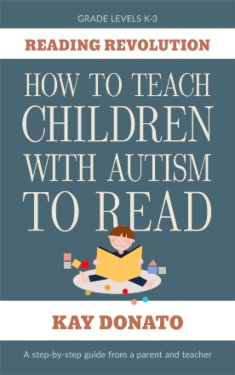| Back to Back Issues Page |
 |
|
Autism news: Sneak peek #2--How to teach your child letter sounds February 09, 2022 |
| Dear Friends, In last week’s sneak peek from the upcoming book, Reading Revolution: How to Teach Children with Autism to Read, you saw that interests and even obsessions can be used to help your child learn. This week’s sneak peek will reveal some of the actual instructions from the book. Excerpts from Chapter 4—Teaching Reading: Starting with the Alphabet
 I bet you’ve already started teaching your child to read without realizing it.
I bet you’ve already started teaching your child to read without realizing it.
Have you ever sung the alphabet song with your child? I’m referring to the English alphabet put to the tune of Twinkle, Twinkle, Little Star. If you’ve been singing that song with your child, you’ve already been teaching pre-reading skills. And if you’ve ever reviewed the letters of the alphabet, or if you’ve ever read a book to your child, you were teaching reading then, too! Because these are all essential activities to teaching reading. So, you’re already a reading teacher!
Start With the Alphabet The place to begin when teaching reading will be the obvious starting point—the alphabet. You’ve probably already started teaching your child the letters of the alphabet and as mentioned earlier, this means you’ve already been teaching reading. Singing the alphabet song is always helpful because it’s easier to learn just about anything when it’s put to music. From there, I would suggest writing each letter on an index card and reviewing the letter sounds every day for at least 5 minutes, increasing gradually to 15 minutes a day. As discussed in chapter 3, you can use just about any other medium your child likes—blocks, reusable stickers, chalk, etc. You don’t have to use flashcards if your child prefers something else.
Teach Only a Few Sounds in the Beginning As briefly mentioned earlier, I suggest that you teach only one sound for each consonant and one sound for each vowel at the beginning. I also suggest that you teach the short vowel sounds in the beginning and practice using words with those sounds. Once your child has learned all the short vowel sounds and can read words with those sounds, you can then teach the long vowel sounds using words containing those sounds. Once your child knows one sound for each consonant and two sounds for each vowel, only one new sound needs to be learned when it appears in a word later on. Smaller chunks of information are much easier to remember than large amounts of material. And too much information at once can be overwhelming in the same way that too many rules and exceptions to rules can create confusion. Waiting to teach other letter sounds worked well for my son. I waited until we came across a word with the new sound to introduce it. For example, if we came to the word happy, I would tell him that in this word, y says ee. For the word large, I would tell him that in this word, g says juh, and the e is silent. Then I would sound it out for him.
Review Both Uppercase and Lowercase Letters Be sure your child is familiar with uppercase and lowercase letters. But to avoid confusion, I would have only one letter on each card. Some flashcards include both the uppercase and lowercase forms on each card—for example, Aa. But I suggest that you avoid that presentation and include only one letter on each card. This is because some kids with autism may take it literally if you combine A and a on one card. They may understand that Aa makes the long a sound but think the uppercase and lowercase versions must appear together to make that sound. The Aa form of flashcards would likely be fine for most typical children, but I would avoid this for children with autism. *********** Next week, I plan to give you another inside look, this time showing you a couple of problems autistic children often have with learning to read and how to overcome them. Until next time, Kay Donato
http://www.aplusasd.com/
|
| Back to Back Issues Page |